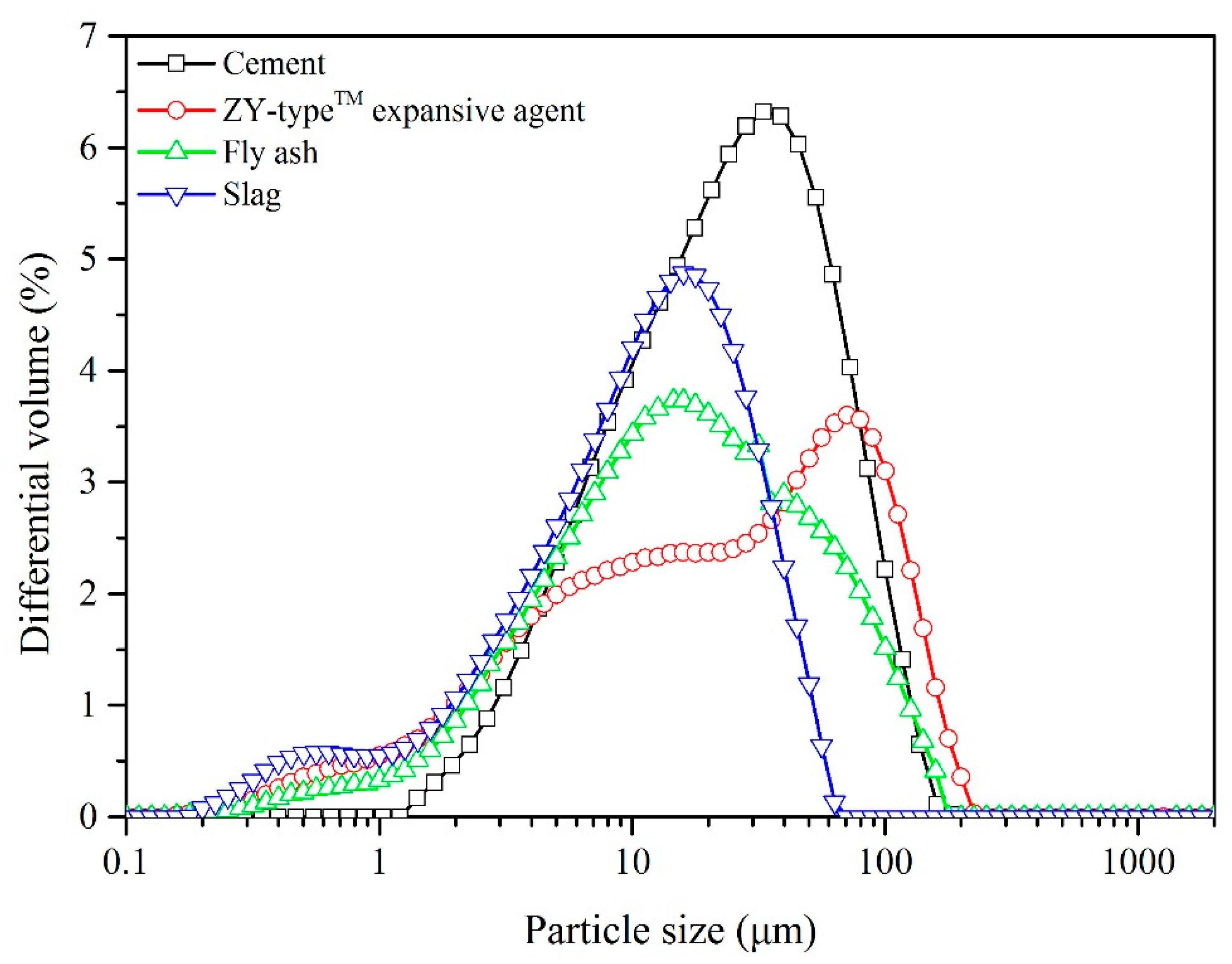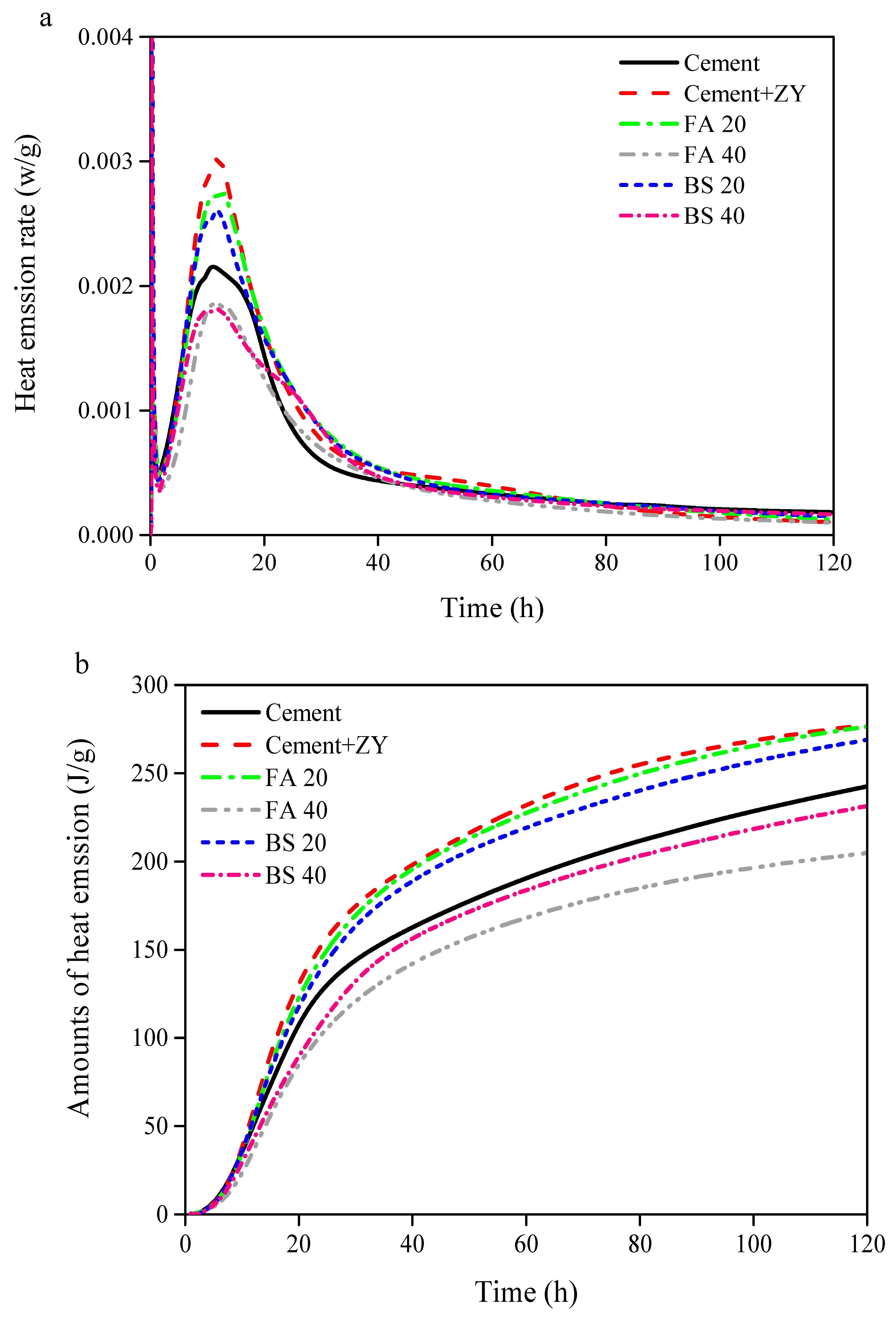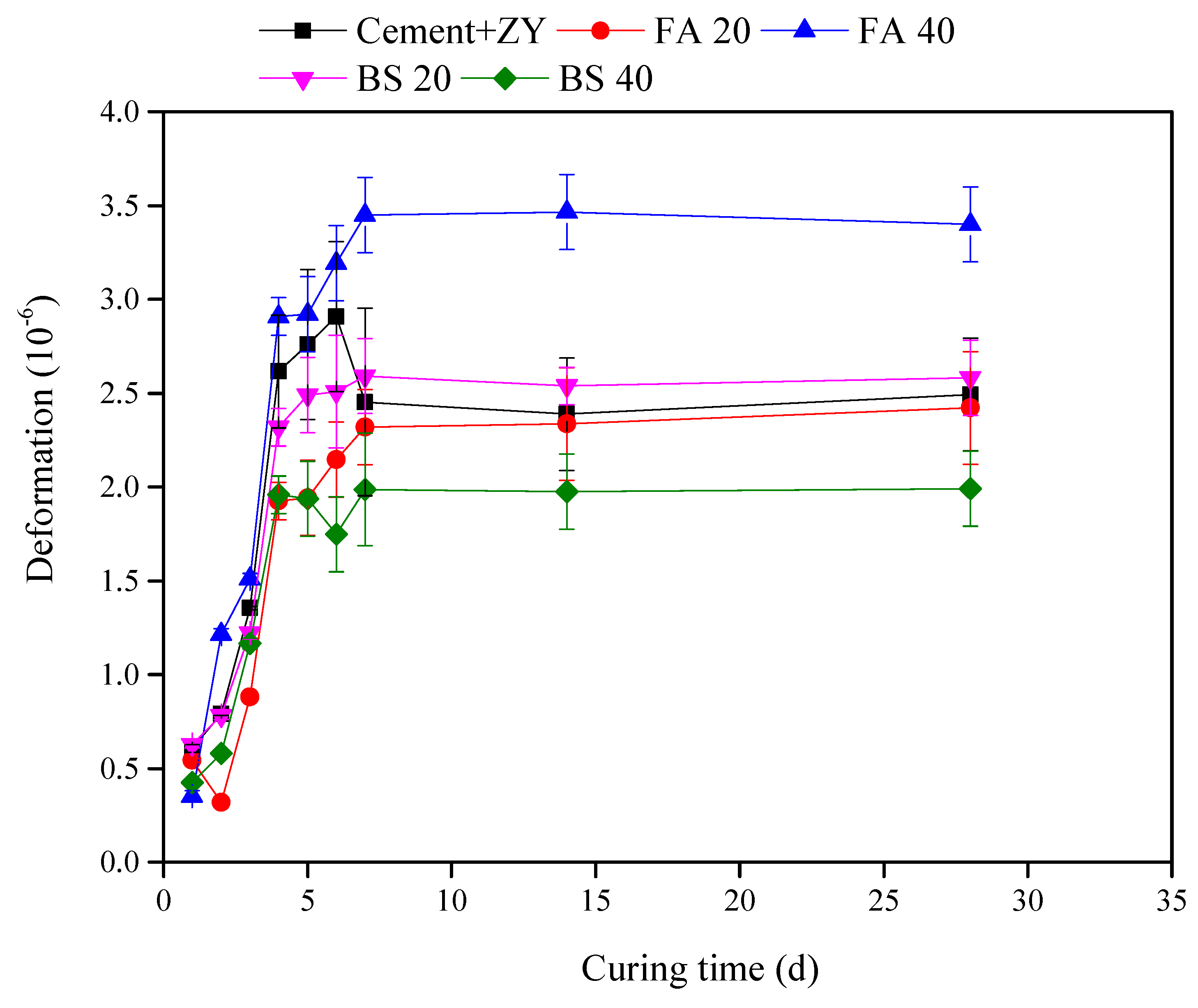Effects of Expansive Agents on the Early Hydration Kinetics of Cementitious Binders
Abstract
:1. Introductions
2. Materials and Methods
2.1. Materials
2.2. Test Methods
2.3. Early Hydration Kinetics
3. Results and Discussion
3.1. Characteristics of Early Hydration Heat of Composite Binders
3.2. Analysis of Early Hydration Kinetic Parameters
3.3. Mechanical Properties and Deformation of Mortars
3.4. Comparisons with Other Expansive Cementitious Binders
4. Conclusions
Supplementary Materials
Author Contributions
Funding
Conflicts of Interest
References
- Ogrodnik, P.; Szulej, J.; Franus, W. The wastes of santitary ceramics as recycling aggregate to special concretes. Materials 2018, 11, 1275. [Google Scholar] [CrossRef] [PubMed]
- Nakamura, K.; Abe, S.; Minamikawa, H.; Yawaka, Y. Calcium Charge and Release of Conventional Glass-Ionomer Cement Containing Nanoporous Silica. Materials 2018, 11, 1295. [Google Scholar] [CrossRef] [PubMed]
- Wang, T.; Tian, X.; Hashimoto, S.; Tanikawa, H. Concrete transformation of buildings in China and implications for the steel cycle. Resour. Conserv. Recycl. 2015, 103, 205–215. [Google Scholar] [CrossRef]
- Li, H.; Deng, Q.; Zhang, J.; Xia, B.; Skitmore, M. Assessing the life cycle CO2 emissions of reinforced concrete structures: Four cases from China. J. Clean. Prod. 2019, 210, 1496–1506. [Google Scholar] [CrossRef]
- Cao, Y.; Gehlen, C.; Angst, U.; Wang, L.; Wang, Z.; Yao, Y. Critical chloride content in reinforced concrete—An updated review considering Chinese experience. Cem. Concr. Res. 2019, 117, 58–68. [Google Scholar] [CrossRef]
- Pacheco, J.; De Brito, J.; Chastre, C.; Evangelista, L. Experimental investigation on the variability of the main mechanical properties of concrete produced with coarse recycled concrete aggregates. Constr. Build. Mater. 2019, 201, 110–120. [Google Scholar] [CrossRef]
- Tran, Y.T.; Lee, J.; Kumar, P.; Kim, K.-H.; Lee, S.S. Natural zeolite and its application in concrete composite production. Compos. Part B: Eng. 2019, 165, 354–364. [Google Scholar] [CrossRef]
- Liu, F.; Shen, S.-L.; Hou, D.-W.; Arulrajah, A.; Horpibulsuk, S. Enhancing behavior of large volume underground concrete structure using expansive agents. Constr. Build. Mater. 2016, 114, 49–55. [Google Scholar] [CrossRef]
- Li, H.; Tian, Q.; Zhao, H.; Lu, A.; Liu, J. Temperature sensitivity of MgO expansive agent and its application in temperature crack mitigation in shiplock mass concrete. Constr. Build. Mater. 2018, 170, 613–618. [Google Scholar] [CrossRef]
- Li, M.; Zhang, M.; Hu, Y.; Zhang, J. Mechanical properties investigation of high-fluidity impermeable and anti-cracking concrete in high roller-compacted concrete dams. Constr. Build. Mater. 2017, 156, 861–870. [Google Scholar] [CrossRef]
- Huang, K.; Shi, X.; Zollinger, D.; Mirsayar, M.; Wang, A.; Mo, L. Use of MgO expansion agent to compensate concrete shrinkage in jointed reinforced concrete pavement under high-altitude environmental conditions. Constr. Build. Mater. 2019, 202, 528–536. [Google Scholar] [CrossRef]
- Dung, N.; Unluer, C. Development of MgO concrete with enhanced hydration and carbonation mechanisms. Cem. Concr. Res. 2018, 103, 160–169. [Google Scholar] [CrossRef]
- Lu, Y.; Shi, G.; Liu, Y.; Ding, Z.; Pan, J.; Qin, D.; Dong, B.; Shao, H. Study on the effect of chloride ion on the early age hydration process of concrete by a non-contact monitoring method. Constr. Build. Mater. 2018, 172, 499–508. [Google Scholar] [CrossRef]
- Zhang, N.; Li, H.; Zhao, Y.; Liu, X. Hydration characteristics and environmental friendly performance of a cementitious material composed of calcium silicate slag. J. Hazard. Mater. 2016, 306, 67–76. [Google Scholar] [CrossRef] [PubMed]
- Wang, Y.; An, M.; Yu, Z.; Han, S. Impacts of various factors on the rehydration of cement-based materials with a low water–binder ratio using mathematical models. Constr. Build. Mater. 2016, 125, 160–167. [Google Scholar] [CrossRef]
- Zhang, H.; Yang, Z.; Su, Y. Hydration kinetics of cement-quicklime system at different temperatures. Thermochim. Acta 2019, 673, 1–11. [Google Scholar] [CrossRef]
- Bernard, O.; Ulm, F.-J.; LeMarchand, E. A multiscale micromechanics-hydration model for the early-age elastic properties of cement-based materials. Cem. Concr. Res. 2003, 33, 1293–1309. [Google Scholar] [CrossRef]
- Fourmentin, M.; Ovarlez, G.; Faure, P.; Peter, U.; Lesueur, D.; Daviller, D.; Coussot, P. Rheology of lime paste—A comparison with cement paste. Rheol. Acta 2015, 54, 647–656. [Google Scholar] [CrossRef]
- Cao, F.; Miao, M.; Yan, P. Hydration characteristics and expansive mechanism of MgO expansive agents. Constr. Build. Mater. 2018, 183, 234–242. [Google Scholar] [CrossRef]
- Krstulović, R.; Dabić, P. A conceptual model of the cement hydration process. Cem. Concr. Res. 2000, 30, 693–698. [Google Scholar] [CrossRef]
- Lin, F.; Meyer, C. Hydration kinetics modeling of Portland cement considering the effects of curing temperature and applied pressure. Cem. Concr. Res. 2009, 39, 255–265. [Google Scholar] [CrossRef]
- Liu, Z.; Li, X.; Deng, D.; De Schutter, G.; Hou, L. The role of Ca(OH)2 in sulfate salt weathering of ordinary concrete. Constr. Build. Mater. 2016, 123, 127–134. [Google Scholar] [CrossRef]
- Benkemoun, N.; Hammood, M.N.; Amiri, O. A meso-macro numerical approach for crack-induced diffusivity evolution in concrete. Constr. Build. Mater. 2017, 141, 72–85. [Google Scholar] [CrossRef]
- Shen, Y.; Chen, X.; Zhang, W.; Li, X.; Qian, J. Influence of ternesite on the properties of calcium sulfoaluminate cements blended with fly ash. Constr. Build. Mater. 2018, 193, 221–229. [Google Scholar] [CrossRef]
- Nath, S.K. Geopolymerization behavior of ferrichrome slag and fly ash blends. Constr. Build. Mater. 2018, 181, 487–494. [Google Scholar] [CrossRef]
- Zhao, S.; Ding, X.; Zhao, M.; Li, C.; Pei, S. Experimental study on tensile strength development of concrete with manufactured sand. Constr. Build. Mater. 2017, 138, 247–253. [Google Scholar] [CrossRef]
- Winnefeld, F.; Martin, L.H.; Müller, C.J.; Lothenbach, B. Using gypsum to control hydration kinetics of CSA cements. Constr. Build. Mater. 2017, 155, 154–163. [Google Scholar] [CrossRef]
- Wang, T.; Xue, Y.; Zhou, M.; Lv, Y.; Chen, Y.; Wu, S.; Hou, H. Hydration kinetics, freeze-thaw resistance, leaching behavior of blended cement containing co-combustion ash of sewage sludge and rice husk. Constr. Build. Mater. 2017, 131, 361–370. [Google Scholar] [CrossRef]
- Thomas, J.J.; Biernacki, J.J.; Bullard, J.W.; Bishnoi, S.; Dolado, J.S.; Scherer, G.W.; Luttge, A. Modeling and simulation of cement hydration kinetics and microstucture development. Cem. Concr. Res. 2011, 41, 1257–1278. [Google Scholar] [CrossRef]



| Materials | SiO2 | Al2O3 | Fe2O3 | CaO | MgO | SO3 | Na2Oeq | f-CaO | LOI |
|---|---|---|---|---|---|---|---|---|---|
| Cement | 21.62 | 4.35 | 3.45 | 64.40 | 3.45 | 2.25 | 0.50 | 0.90 | 1.25 |
| Fly ash | 46.89 | 24.53 | 13.55 | 1.35 | 2.07 | 0.63 | 1.57 | - | 5.68 |
| Slag | 32.70 | 14.03 | 0.50 | 39.00 | 8.99 | 0.20 | 0.52 | - | 0.78 |
| ZY | 7.24 | 13.66 | 2.23 | 32.13 | 2.50 | 33.71 | 0.12 | - | 6.83 |
| Sample | W/B | Cement | Fly Ash | Slag | ZY-type™ Expansive Agent |
|---|---|---|---|---|---|
| Cement | 0.4 | 100 | 0 | 0 | 0 |
| Cement + ZY | 0.4 | 94 | 0 | 0 | 6 |
| FA20 | 0.4 | 74 | 20 | 0 | 6 |
| FA40 | 0.4 | 54 | 40 | 0 | 6 |
| BS20 | 0.4 | 74 | 0 | 20 | 6 |
| BS40 | 0.4 | 54 | 0 | 40 | 6 |
| Samples | n | K1′ | K2′ | K3′ | Kinetics Mechanism |
|---|---|---|---|---|---|
| Cement | 1.946 | 0.0489 | 0.0133 | 0.00269 | NG-I-D |
| Cement + ZY | 1.818 | 0.0451 | 0.0121 | 0.00266 | NG-I-D |
| FA 20 | 1.792 | 0.0417 | 0.0105 | 0.00216 | NG-I-D |
| FA 40 | 1.741 | 0.0386 | 0.00961 | 0.00201 | NG-I-D |
| BS 20 | 1.788 | 0.0404 | 0.00955 | 0.00191 | NG-I-D |
| BS 40 | 1.649 | 0.0332 | 0.00715 | 0.00147 | NG-I-D |
| Samples | 3 d | 7 d | 28 d | 90 d |
|---|---|---|---|---|
| Cement | 28.5 | 37.7 | 54.2 | 64.9 |
| Cement + ZY | 35.2 | 42.2 | 59.8 | 69.0 |
| FA 20 | 23.7 | 34.6 | 50.4 | 58.2 |
| FA 40 | 21.1 | 28.2 | 39.7 | 51.7 |
| BS 20 | 25.9 | 35.3 | 53.9 | 63.7 |
| BS 40 | 25.4 | 32.2 | 49.9 | 59.3 |
| Study | Expansive Agent | Early Hydration Kinetics | Technical Use * |
|---|---|---|---|
| Cao et al. [19] | MgO | n.a. | Yes |
| Winnefeld et al. [27] | CaSO4 | n.a. | Yes |
| Wang et al. [28] | Sewage sludge | NG-D | Yes |
| Our study | ZY-type™ | NG-I-D | Yes |
© 2019 by the authors. Licensee MDPI, Basel, Switzerland. This article is an open access article distributed under the terms and conditions of the Creative Commons Attribution (CC BY) license (http://creativecommons.org/licenses/by/4.0/).
Share and Cite
Miao, M.; Liu, Q.; Zhou, J.; Feng, J. Effects of Expansive Agents on the Early Hydration Kinetics of Cementitious Binders. Materials 2019, 12, 1900. https://doi.org/10.3390/ma12121900
Miao M, Liu Q, Zhou J, Feng J. Effects of Expansive Agents on the Early Hydration Kinetics of Cementitious Binders. Materials. 2019; 12(12):1900. https://doi.org/10.3390/ma12121900
Chicago/Turabian StyleMiao, Miao, Qingyang Liu, Jian Zhou, and Jingjing Feng. 2019. "Effects of Expansive Agents on the Early Hydration Kinetics of Cementitious Binders" Materials 12, no. 12: 1900. https://doi.org/10.3390/ma12121900





